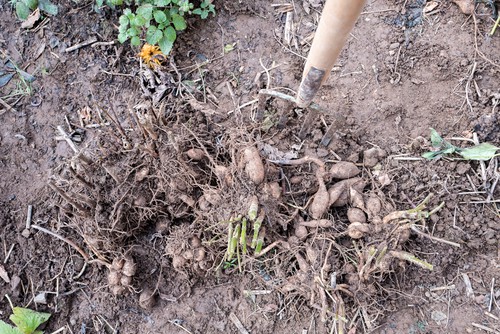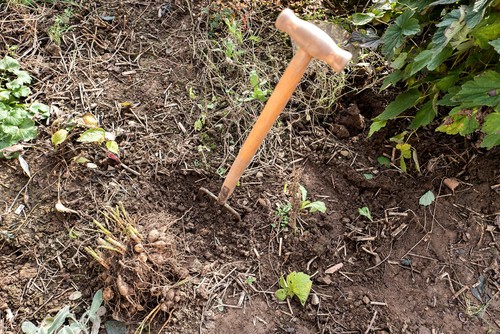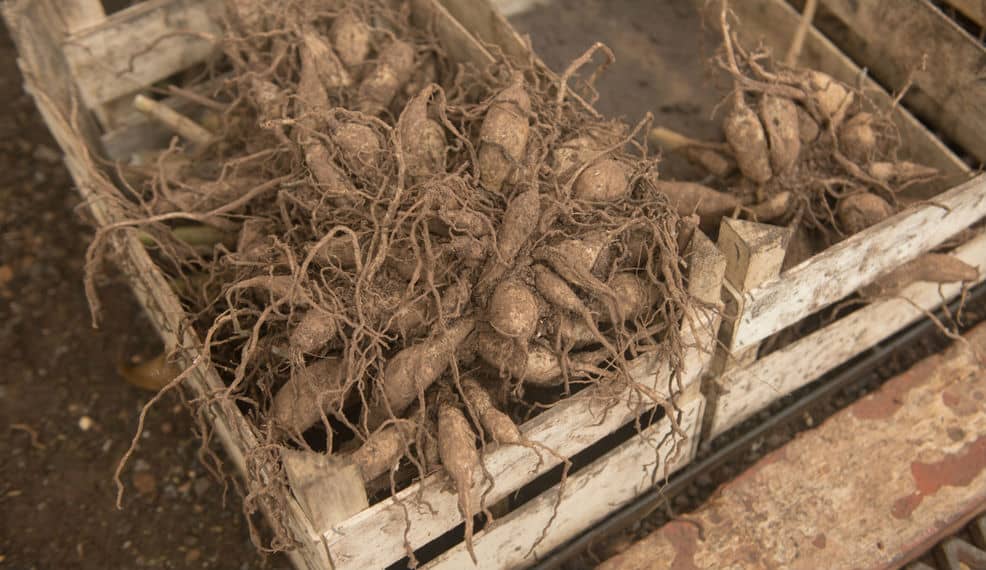Last updated on March 8th, 2022
Our site is reader supported, this means we may earn a small commission from Amazon and other affiliates when you buy through links on our site.
Dahlias are a beautiful summer flower but winter is not their favourite season. They need to be taken out of colder gardens where the frost may be hard and freeze deeper than the first few inches of soil and stored over winter. If you leave them in the garden and you have a period of cold, the freezing temperatures will actually kill them.
The good news is that lifting them is pretty straightforward and nearly always guarantees they will produce another fantastic show the following summer.
Can you leave Dahlias in the ground over winter?
That is really dependent upon where you live. If you happen to live in a mild area of the country where the ground doesn’t freeze too deeply during the winter, you can theoretically leave your Dahlias in the ground, as long as you add a few inches of mulch (such as compost or leaf mould) over the bed and the soil is free draining they will be just fine. However, overwintering Dahlias in the ground in regions where you have freezing temperatures regularly will kill them off and they may not survive thereafter.

Overwintering Dahlias in the Ground
If you live in a milder part of the UK you want to start by covering the soil around your Dahlias with mulch. You should have between 3-6 inches of mulch, which can be comprised of wood chips, leaf mould or other organic materials and compost.
The following spring you need to remove the mulch and give the soil the opportunity to warm up. Between March and April, you need to dig up the Dahlia tubers and then replant them if you want to cultivate the best flowers, although many gardeners simply remove the mulch and leave them as they are.
Overwintering Dahlias Tubers by Lifting Them
If you live in an area that’s too cold to leave your Dahlias outside you can overwinter them indoors. This is the best way to give your Dahlias a break during the winter months and is believed by many gardeners to encourage a stronger floral production the following spring.

You will need to start by digging up your Dahlias immediately after the first frost. The first frost will kill the leaves and stems and they will start to turn black. This forces the tuber into dormancy for the winter and as soon as this happens you can trim your Dahlia back to anywhere between 5cm and 15cm. Doing so will also make it much easier to remove the roots.
Wait until it is not raining before you dig up the plants. At which point, use a garden fork to carefully dig up your tubers, pushing the soil about 15cm away from the flower all the way around the perimeter to loosen the soil near the tuber without actually piercing it. If you don’t have a garden fork you can always use a spade but be extra careful.

During this time you need to be considerate about lifting the tuber and avoid damaging the outer skin. If you damage the outer skin it leaves the tuber more susceptible to diseases and rotting when being stored.
Once you have removed it from the ground it’s time to clean everything up by trimming away the dead stems and breaking off the soil around it with your hand. We don’t recommend washing the tubers with water because this can cause them to rot later on. This simply reduces the chances of diseases whilst the plant is being stored over winter.
Before you store your Dahlias it’s time to let them dry out. You need to lie them on a flat surface somewhere it will be protected from the sun and wind. It’s best to set them on something like newspaper and allow them to dry out for around a week to ensure they are very dry and ready to store. You can also hang them upside down to dry them off, a method that some gardeners prefer.

At this point, it’s time to store them properly and it’s in your best interest to coat each tuber with Bordeaux mixture before you store them so that they are protected against fungal growth during the winter. Once they have dried you can place them in a box lined with newspaper and then cover each of them with a layer of peat moss followed by another layer of newspaper on top of everything else.
Close up the box and if you have different varieties, label each box accordingly. If you don’t want to use peat moss you can also store them in boxes or trays that have compost, sand or potting soil. No matter what you use, you do need to store them in a cool frost-free area such as a garage, shed or cellar. If the temperature freezes it will kill your tubers so don’t store them outside.
Every month you should check the tubers for disease and sprinkle them with water if they are starting to dry out. When spring comes around you can move that container or box underneath a window so that they make the transition and start to warm up again, even if it’s not yet warm enough outside for them to be planted. Come spring, you can replant your tubers, either in pots to start them off or in the ground, but don’t do this too early because the frost will damage any new growth.


